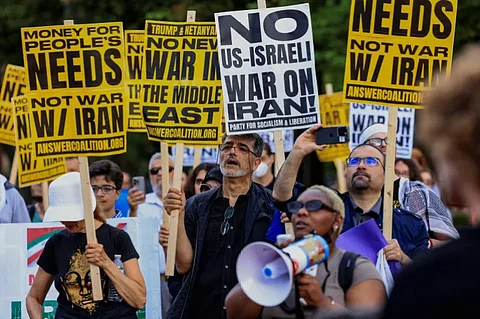

The confrontation between Israel and Iran intensified on Wednesday night, with Israel claiming to have destroyed Iran’s internal security headquarters in Tehran. The airstrike, part of a broader Israeli campaign, follows six consecutive nights of attacks targeting Iran’s military and symbolic state institutions, including its police headquarters and state broadcaster.
At least 240 Iranians, including 70 women and children, have reportedly died in the Israeli airstrikes. Meanwhile, Iranian missile barrages have killed 24 civilians in Israel. The United Nations and multiple human rights groups have voiced concern, as the civilian toll continues to rise on both sides.
Amid the intensifying hostilities, US President Donald Trump has yet to make a final decision on whether the United States will join Israel in its war against Iran. While Trump approved initial military planning and authorised the movement of refuelling aircraft to Spain and Greece for potential B-2 bomber missions, he maintained ambiguity, stating, “I may do it, I may not do it.”
Iran’s Supreme Leader Ayatollah Ali Khamenei responded sharply, warning the US of “irreparable harm” if it intervenes. Iranian forces, according to US intelligence cited by The New York Times, have begun preparing for strikes on American bases in the region in case of US involvement.
Israel’s campaign, which began with the stated aim of neutralising Iran’s nuclear and missile programmes, appears to have expanded into a broader effort to destabilise Iran’s regime. Israeli Prime Minister Benjamin Netanyahu has publicly supported the idea of regime change, stating, “We are creating the conditions” for the Iranian people to rise up. Defence Minister Israel Katz echoed this view, claiming that a “tornado is sweeping through Tehran” as symbols of power collapse.
In parallel with military operations, diplomatic manoeuvres are under way. Iran has signalled willingness to negotiate with Western powers—excluding the US—on its nuclear programme. Talks involving the foreign ministers of the UK, France, and Germany are expected to take place in Geneva on Friday, alongside EU foreign policy chief Kaja Kallas. However, Iran has refused to engage with Trump’s envoy, citing US support for Israeli strikes.
Despite Trump’s claim that Iranian officials had requested a White House meeting, Iran’s UN mission strongly denied this, calling the assertion false and demeaning.
Meanwhile, the Pentagon has deployed the USS Carl Vinson to the Arabian Sea and redirected the USS Nimitz from Singapore to the region. Air-defence resources remain under pressure, with Israel’s supply of Arrow interceptor missiles reportedly dwindling.
The International Atomic Energy Agency confirmed that Israeli strikes have damaged two Iranian uranium centrifuge facilities. While Iran maintains that its nuclear programme is peaceful, its enrichment levels—approaching weapons-grade—have raised international alarms.
With both sides escalating attacks and diplomatic options narrowing, the prospect of a broader regional conflict involving the US remains a pressing concern. Mediation efforts by Qatar, Oman, and Russia continue, but the path to de-escalation remains uncertain.